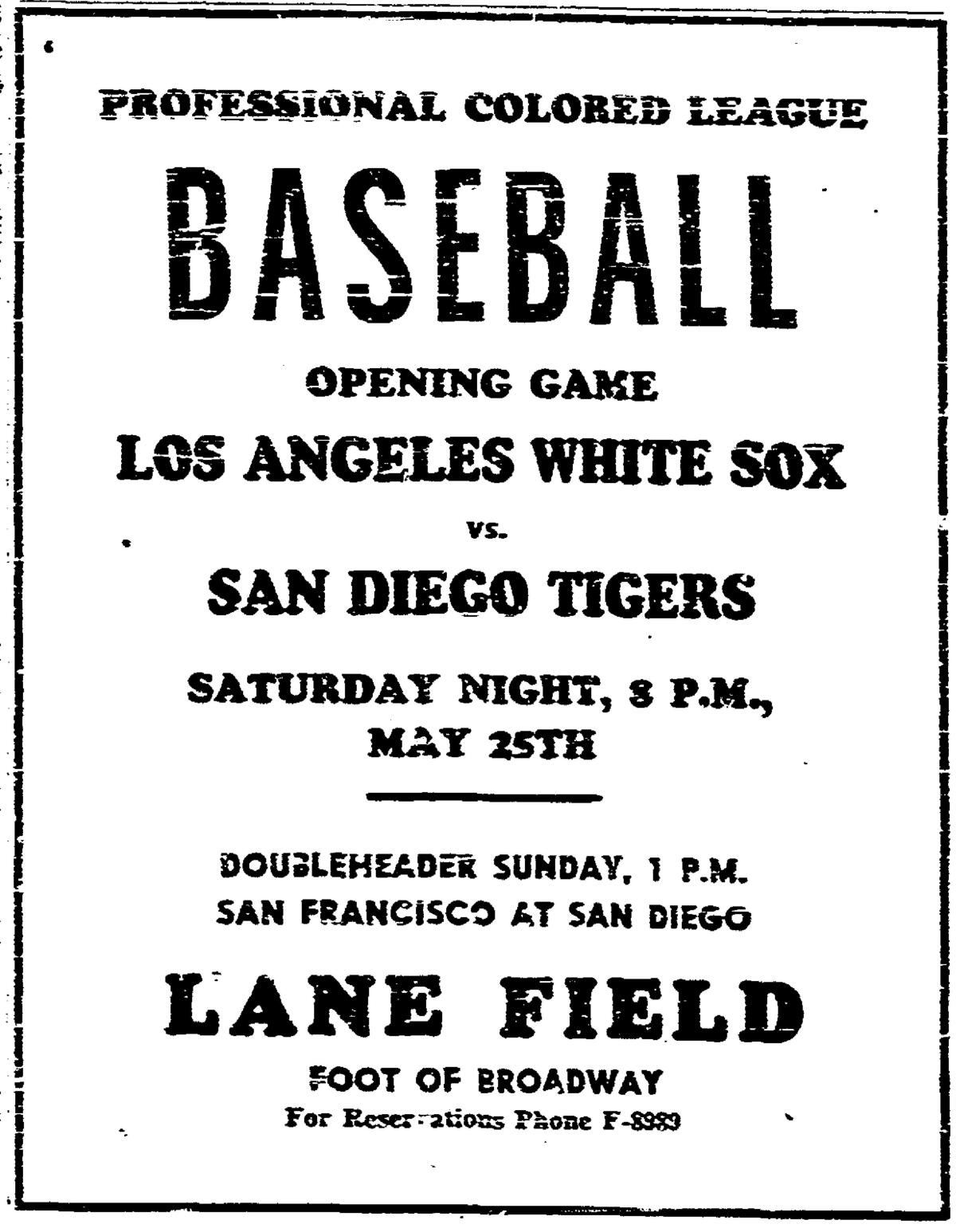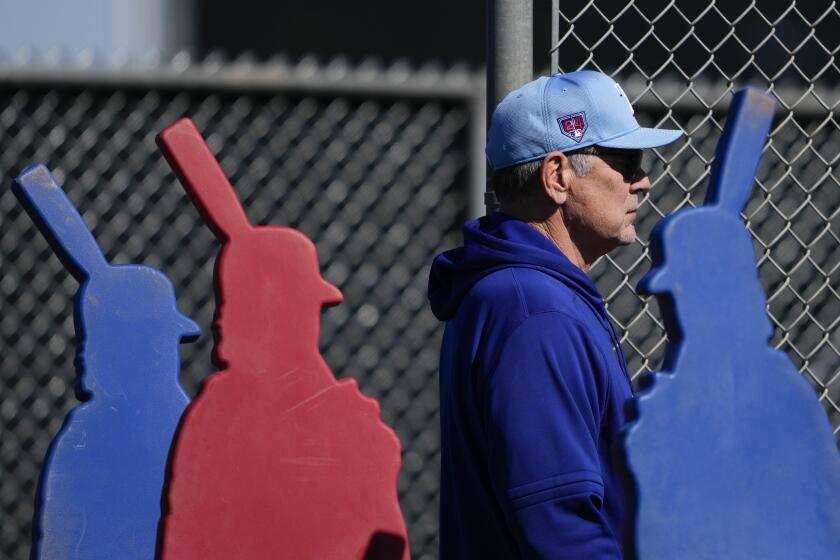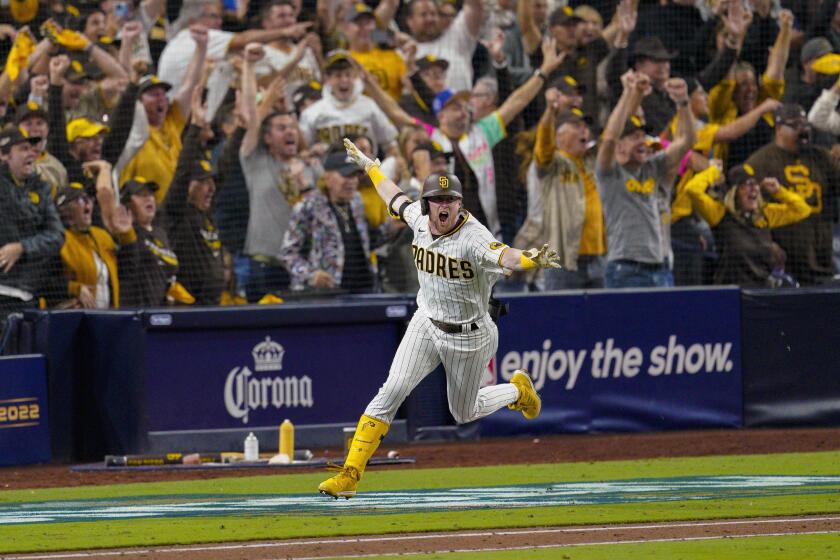Tigers’ tale: Nearly 80 years ago, San Diego fielded an all-Black baseball team in a pioneering league

The San Diego Tigers played as part of the West Coast Negro Baseball Association, a league backed by Olympic star Jesse Owens and others
In 2005, my friend, former Chicago American Giants pitcher Walter McCoy, asked me to drive him to Oakland to attend a tribute to the Negro Leagues. During the trip, Walt told me that he and Johnny Ritchey, the man who broke the Pacific Coast League’s color barrier, both played professionally for the San Diego Tigers.
I knew Johnny played with the local semi-pro Gibson Tigers, but was unaware of a Negro league in California — or that San Diego had a team in it.
While in Oakland, we visited the African American Museum & Library to research the Tigers. Access was denied. The information was guarded as tightly as if it contained Cold War secrets … or possibly it was non-existent.
At the time, there seemed little interest in this fascinating history.
In 1945, the West Coast Negro Baseball Association was founded by Berkeley firemen Eddie Harris and David Portlock, prominent members of the High Marine Social Club — the oldest African American organization in the East Bay.
Their ambitious plans were to start baseball teams in Oakland, San Francisco, Seattle, Portland, Los Angeles and, yes, San Diego.
The Seattle Steelheads franchise was awarded to Abe Saperstein, owner of the Harlem Globetrotters. Olympic track and field champion Jesse Owens would operate the Portland Rosebuds team. The San Diego franchise holder was league secretary A.I. Ramsey.
On paper, the league appeared viable. California governor Earl Warren was scheduled to throw the first pitch at a game between the San Francisco Sea Lions and Los Angeles White Sox in San Francisco.
The season opened on May 12, 1946 at Italian Entertainment Park... or was it Fresno Midget Auto Racing Park? Or Fresno State College Park? The Oakland Larks defeated the Fresno Tigers, 14-1 … or was it 16-1?
The Fresno Tigers? What were San Diego’s Tigers doing in Fresno?
Four days later, The California Eagle — the largest African American newspaper in the state — reported, “First looked upon as a ‘weak sister’ of the league, the Fresno Tigers, managed by Dick ‘Pee Wee’ Bradley, a retired officer and first sergeant, have made everyone sit up and take notice.”
Anyone who did sit up and take notice realized the Tigers were weak sisters.
Regardless, The Fresno Bee touted that: “The Tigers lineup includes Negro baseball stars from throughout the country.” In reality, their only player with Negro League experience was ancient William “Stack” Martin, who played with Indianapolis and Detroit in the 1920s.
On May 22, 1946, The Bee announced the Tigers would move to San Diego and play their home games at Lane Field. The team would have a new manager, Sticks Smith, who it called a “pioneer of Negro baseball.” According to the Las Vegas Review-Journal: “Old timers remember the famous slugger as holding the distinction of being the only colored player ever to knock a home run out of a Pacific coast baseball park.”
No other records can be found for Mr. Smith. My research about this mysterious team hit a brick wall.
In 2018, Gwenn Spratt — an amateur historian from Visalia — contacted the San Diego Public Library’s Baseball Research Center requesting information about the former Fresno Tigers. All she knew was the team moved to San Diego and their record was 4-6 when the league folded.
The library contacted me and I was immediately impressed with Gwenn’s enthusiasm. Using the library’s collection of San Diego Union microfilm, I was able to find two more games played by the Tigers. Their record improved to 5-7.
Then my research on the subject again went into hibernation.
Earlier this year, San Diego Padres archivist Sandy O’Toole became curious about the Tigers. There has been mass digitization of archival newspapers since 2005. Ted Williams SABR Chapter President Tom Larwin compiled a treasure chest containing 211 newspaper articles about the ill-fated West Coast Baseball Association ... and the San Diego Tigers.
An observation in the May 27, 1946 San Diego Union stated: “Judged off the three week-end games here, the Pacific Coast Negro Baseball league doesn’t measure up to the P.C.L. in playing performance, but the Padres, Seals, Angels, et al, are far below the dusky diamondeers in hustle and spirit.” Pacific Coast League officials were uncooperative when approached by the founders of the WCBA.
From these new resources, scores from four additional Tigers games were uncovered. Apparently three more games were played, but the scores are unknown. The first San Diego Tigers box scores were found for a June 30, 1946 doubleheader between the Tigers and Sea Lions at Seals Stadium in San Francisco.
The box scores helped clarify the starting nine. Chappie Gray Jr. was the team’s featured player. His father, Theodore Roosevelt “Chappie” Gray Sr., was briefly with the Kansas City Monarchs in 1920, the first year of Rube Foster’s Negro National League. It appears young Chappie led the WCBA in stolen bases.
The most interesting Tiger was Ted Gabe. Descended from Oklahoma Territory Creek Freedmen, he attended the Oklahoma Industrial Institute for the Deaf, Blind and Orphans of the Colored Race, the University of Washington, the University of California and San Quentin State Prison. During World War II, he worked at and played ball for the Kaiser Shipyards in Richmond. After the WCBA collapse, Gabe completed his degree at Berkeley and became a photographer for National Geographic.

Little is known about the other Tigers players. Some had interesting nicknames like Dirt Man Robinson, Smokey Joe Hayden, Socco Henderson and Caledonia Dwight McCollum. A San Francisco Chronicle article tactlessly noted the Tigers also had a “Caucasian and/or pure Aryan” relief pitcher named Ben Klocke. Nothing further could be found about Klocke.
The Tigers’ last league game took place on July 2, 1946 against the Sea Lions in Vallejo. San Diego won 12-8, with Stanley “Moose” Mouton going 4 for 5 and belting a 340-foot home run.
This latest information confirms the San Diego Tigers posted at least a 5-11 record (and possibly 7-13) before their league folded. The cause of the collapse, of course, was money. Not enough revenue was generated to cover player salaries, ballpark rental, transportation, housing and additional sundry expenses.
San Francisco co-owner John Harold “Yellowhorse” Morris claimed to have lost $30,000 on the Sea Lions, equivalent to almost half a million in today’s dollars.
The Oakland Larks were the class of the league and their record continued to improve even after June 10, when the California Eagle ran what was long believed to be the final standings. Their star pitcher, Lionel “Lefty” Wilson, became California’s first African American judge in 1961 and Oakland’s first African American mayor, serving three terms from 1977 to 1991.
The 1946 West Coast Negro Baseball Association was a progressive post-war idea, visionary in its attempt to expand “big time” baseball beyond the Mississippi River. Realistically, with the integration of baseball on the horizon, success of the league was doomed from the start. Jackie Robinson broke Major League Baseball’s color barrier on April 15, 1947 — less than a year after the upstart association’s final game.
The San Diego Tigers survived into the early 1950s as a barnstorming venture, later becoming known as the California Tigers. This was the team McCoy and Ritchey played for in 1947. Former Kansas City Monarchs pitcher and San Diego native Gene Richardson also played for the California Tigers.
In 2020, Major League Baseball formally recognized the Negro Leagues as major leagues. Four years later, the task of reconstructing Negro Leagues statistics remains as daunting as ever. Baseball is a game of numbers, and Negro league numbers can be elusive.
Hopefully in the future, researchers will flesh out the West Coast Baseball Association.
In the meantime, the Tigers hold a special place in the rich history of San Diego baseball.
Baseball historian Bill Swank is the leading expert on early San Diego baseball, including the Lane Field Era (1936-57). He has authored and co-authored six books on San Diego baseball.
Go deeper inside the Padres
Get our free Padres Daily newsletter, free to your inbox every day of the season.
You may occasionally receive promotional content from the San Diego Union-Tribune.





